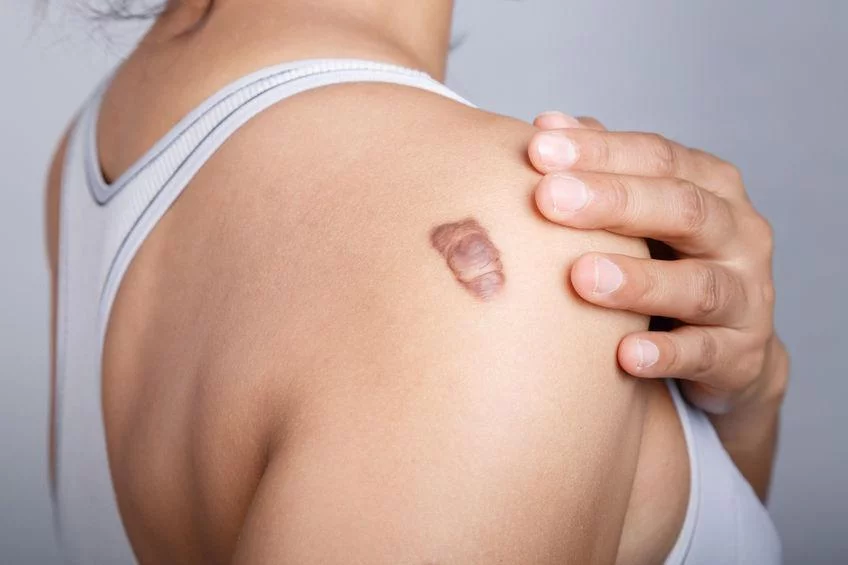Keloid - Symptoms, Causes, Prevention & Homeopathic treatment

Overview
Keloids are raised, overgrown areas of scar tissue that develop at the site of a skin injury. Unlike regular scars, keloids grow beyond the boundaries of the original wound and do not regress over time. They can occur from various types of skin injuries, including surgical incisions, piercings, burns, or even minor abrasions. Keloids can cause discomfort, itching, and cosmetic concerns, significantly impacting a person’s quality of life. Homeopathy offers a holistic approach to managing keloids, addressing both the physical manifestations and underlying causes.
Symptoms
The symptoms of keloids include:
- Raised, Thickened Scars: The primary symptom is a raised, thick, and often shiny scar that extends beyond the original wound.
- Red or Purple Coloring: Initially, keloids may appear red or purple, becoming darker over time.
- Itching and Pain: Keloids can be itchy, tender, or even painful, particularly during their early stages of development.
- Growth Over Time: Unlike regular scars, keloids may continue to grow and spread over months or even years.
- Tightness: Large keloids can cause tightness or restricted movement, especially if they occur over joints.
When to see a doctor
Consult a healthcare provider if:
- Rapid Growth: The keloid is growing rapidly or changing in appearance.
- Pain and Discomfort: There is significant pain, itching, or discomfort that affects daily activities.
- Infection Signs: The keloid shows signs of infection, such as redness, warmth, or discharge.
- Cosmetic Concerns: The appearance of the keloid causes emotional distress or affects self-esteem.
- Functional Impairment: The keloid restricts movement or function, especially if it is located near a joint.
Causes
Keloids form due to an overactive healing response in the skin. The exact cause is not fully understood, but factors that contribute include:
- Skin Injury: Any skin injury, including cuts, burns, surgical incisions, or acne, can trigger keloid formation.
- Genetic Predisposition: A family history of keloids increases the likelihood of developing them.
- Skin Type: People with darker skin tones are more prone to keloid formation.
- Age: Keloids are more common in younger individuals, particularly those aged 10 to 30.
Risk factors
Several factors increase the risk of developing keloids:
- Genetics: A family history of keloids significantly raises the risk.
- Skin Type: Individuals with darker skin tones are more susceptible.
- Age: Young people, especially during puberty, are at higher risk.
- Injury Type: Severe skin injuries or those that take longer to heal are more likely to develop keloids.
Complications
While keloids are benign and not life-threatening, they can lead to complications such as:
- Cosmetic Concerns: The appearance of keloids can cause emotional distress and impact self-esteem.
- Physical Discomfort: Itching, tenderness, and pain can affect daily activities and quality of life.
- Movement Restriction: Large keloids over joints can restrict movement and flexibility.
- Secondary Infections: If the skin is repeatedly irritated or scratched, it may become infected.
Preventions
Preventing keloids involves minimizing skin injuries and taking prompt action if an injury occurs:
- Proper Wound Care: Clean and cover wounds promptly to prevent infections and promote proper healing.
- Avoid Unnecessary Skin Trauma: Be cautious with piercings, tattoos, and other procedures that can injure the skin.
- Pressure Therapy: Use pressure garments or silicone gel sheets on healing wounds to reduce the risk of keloid formation.
- Avoid Sun Exposure: Protect healing skin from sun exposure to prevent pigmentation changes that can worsen keloids.
Can Homeopathy Help?
Homeopathy can offer a gentle and effective approach to managing keloids by addressing the underlying tendencies and promoting natural healing. Some homeopathic remedies that may be considered include:
- Thiosinaminum: Known for its effectiveness in treating scar tissue and reducing keloids.
- Silicea: Used for keloids that are hard, sensitive, and painful.
- Graphites: Beneficial for keloids that are itchy and accompanied by thick, oozing skin.
- Calcarea Fluorica: Helps in managing hardened scar tissue and promoting elasticity in the skin.
- Hepar Sulph: Used for painful, inflamed keloids that may be prone to infection.
A qualified homeopathic practitioner will conduct a thorough assessment to select the most appropriate remedy based on the individual’s overall health and specific symptoms.
Diagnosis
Diagnosing keloids typically involves:
- Clinical Examination: A visual inspection by a healthcare provider to assess the scar’s size, shape, and growth pattern.
- Medical History: A review of the patient’s medical and family history, including any previous instances of abnormal scarring.
- Biopsy: In some cases, a biopsy may be performed to confirm the diagnosis and rule out other skin conditions.
Treatment
Treatment options for keloids aim to reduce their size, alleviate symptoms, and improve cosmetic appearance:
- Steroid Injections: Corticosteroids can be injected directly into the keloid to reduce inflammation and flatten the scar.
- Surgical Removal: Keloids can be surgically removed, but there is a risk of recurrence, often larger than the original.
- Laser Therapy: Laser treatments can reduce the size and discoloration of keloids.
- Cryotherapy: Freezing keloids with liquid nitrogen can help reduce their size.
- Silicone Sheets and Gels: These can be applied to the keloid to flatten and soften the scar over time.
- Homeopathic Remedies: As mentioned, remedies tailored to the individual’s symptoms can be integrated into the treatment plan.
Lifestyle and home remedies
In addition to professional treatments, certain lifestyle changes and home remedies can support skin health and manage keloids:
- Moisturizing: Regularly applying moisturizers can keep the skin hydrated and reduce itchiness.
- Gentle Skin Care: Use mild, fragrance-free soaps and avoid harsh scrubbing.
- Avoiding Irritation: Protect the keloid from physical irritation or pressure, which can worsen the condition.
- Healthy Diet: A diet rich in vitamins and antioxidants can support overall skin health.
- Natural Remedies: Applying natural products like aloe vera, honey, or onion extract may help reduce keloid size and discomfort.
Preparing for your appointment
To make the most of your appointment with a healthcare provider or homeopathic practitioner:
- Document Symptoms: Keep a detailed record of the keloid’s development, including any changes in size, color, and symptoms.
- Medical History: Provide information about any previous skin conditions, treatments, and family history of keloids or abnormal scarring.
- Questions: Prepare questions about treatment options, potential side effects, and lifestyle changes to manage keloids.
- Current Medications: List any current medications or supplements you are taking, including any topical treatments.
